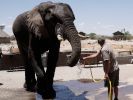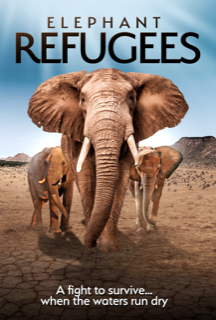Eye For Film >> Movies >> Elephant Refugees (2020) Film Review
Elephant Refugees
Reviewed by: Jennie Kermode

Nobody know how they explained the situation to each other, but when Botswana outlawed elephant hunting, elephants began to migrate there from across half the continent. They came from South Africa, Namibia, Angola, Zambia, Malawi, Zimbabwe and Mozambique, sometimes as many as 500 a day, following their ancient pathways, arriving in the dry, sandy Kalahari woodlands in the east of the country hungry, thirsty and exhausted. What they found there was the Moller family’s bush lodge, now known as Elephant Sands.
It began with guests at the lodge reporting that when they were showering, the water had suddenly cut out, and they had looked up to see elephant trunks curling over the top of the stalls and grabbing the shower heads. One elephant figured out how to turn on the tap on a sink, take a drink, and then turn it off again, but most were not that helpful. Fortunately for them, Marie and Ben Moller were immediately sympathetic to their plight. They faced a significant struggle of their own, trying to keep the facilities in good repair for guests on whom they were financially dependent, but they were determined to do all they could for the elephants, improving access to the local watering hole and wading through bureaucracy in an attempt to get permission to set up a separate drinking trough.

The situation, as captured on camera by director Louise Hogarth and cinematographer Alistair Lyne, is a complex one. The end of hunting meant that pumps which had drawn up water from boreholes in the surrounding region were abandoned, dramatically reducing the supply of water just as demand rose (it is explained that an adult elephant drinks the equivalent of a bathtub full of water per day). Elephants who might be considerate to one another in normal circumstances behave differently under this kind of stress, some of them trying to monopolise the water supply, or letting calves drink but refusing that favour to their exhausted mothers. They get in fights, resulting in nasty tusk injuries. One, called Wireman, finds a means of breaking the electric fence which shields water tanks so that he can drink directly from them, inviting a handful of friends to join him. A female called Toothless is described as ‘very naughty’ for her habit of knocking the tops off toilets – often breaking them – so that she can drink from the cisterns.
Mary, struggling to find water for her children, resorts to digging up a sewer, which could have awful consequences for their health. Several of the elephants have injuries which urgently need treatment, but the Mollers are again held up by bureaucracy as they try to get a licence to treat them. A baby called Tripod walks on just three legs, awkwardly supporting a deformed fourth one, and is plainly wasting away. A bull, Bennie, decides to take a chance on directly asking the humans to help with his injured foot. Even when all they can do is to spray cooling water onto it, he is clearly grateful.
The respect which the elephants have for the humans is intriguing – and sometimes comical – to behold. By night, they careful tiptoe between the tents of sleeping guests, without disturbing them. They are wary of the Mollers’ dogs, however, which is perhaps fortunate, as Pieter, the smallest and loudest, seems to have no cognisance of how easily they could injure him, and has to be dissuaded from asserting himself as master of his domain.
With so much going on, there is an abundance of stories for Hogarth to tell. She spends time with the extended Moller family as well as with the elephants, and we also meet some of the tourists, who seem happy enough to put up with a bit of inconvenience in exchange for the unrivalled experience of being so close to the elephants. Warthogs and hyenas also wander by; the human children know to be wary of the latter. There are dangers here, but both humans and elephants are careful, respectful, even in extremis.
With a disturbing piece of news at the end throwing everything that has gone before into question, this is a highly emotive film, but Hogarth knows better than to rely on that and packs it full of interesting observations as well. As such, its appeal will extend far beyond animal lovers (some of whom will find parts of it upsetting). The motivation for the migration in this case may be legal change, but in a world in which climate change is making habitable territories smaller and increasingly forcing humans and wild animals to compete for the same finite resources, it illustrates how, in spite of difficulties, such situations can be managed well.
Reviewed on: 15 Nov 2022

















